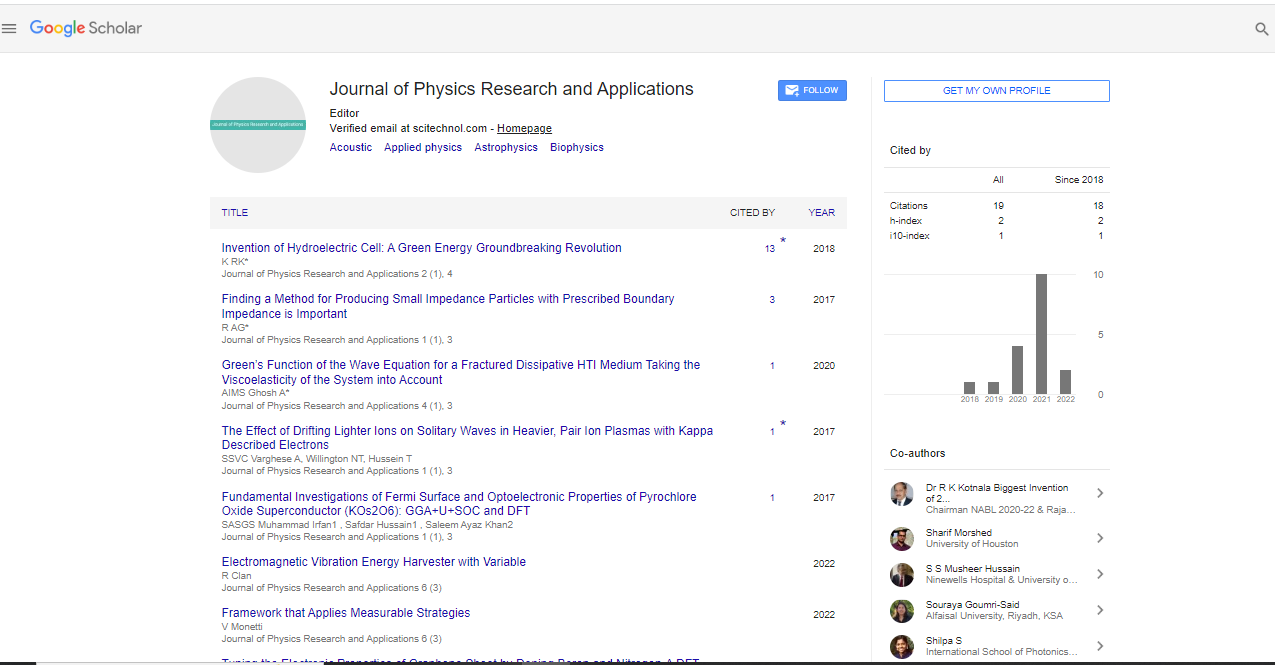Perspective, J Phys Res Appl Vol: 8 Issue: 4
Metastable Phases in Metallic Systems: An Atomic Perspective
Makoto Yasutomi*
1Department of Physics, University of the Ryukyus, Okinawa, Japan
*Corresponding Author: Makoto Yasutomi,
Department of Physics, University of the Ryukyus, Okinawa, Japan
E-mail: makoto@yast.jp
Received: 19 November, 2024, Manuscript No. JPRA-24-156515;
Editor assigned: 21 November, 2024, PreQC No. JPRA-24-156515 (PQ);
Reviewed: 06 December, 2024, QC No. JPRA-24-156515;
Revised: 13 December, 2024, Manuscript No. JPRA-24-156515 (R);
Published: 20 December, 2024, DOI: 10.4172/JPRA.1000131.
Citation: Yasutomi M (2024) Metastable Phases in Metallic Systems: An Atomic Perspective. J Phys Res Appl 8:4.
Description
Metastable phases in metallic systems have importance in materials science and condensed matter physics. These phases, which exist outside the thermodynamic equilibrium of a material exhibit unique structural and functional properties that differ from their stable counterparts. Understanding the formation, stability and transformation of metastable phases at the atomic level provides valuable information about the materials for advanced applications. In thermodynamic terms, a metastable phase is not the most energetically favorable state but remains kinetically trapped, preventing it from transitioning to the equilibrium state under certain conditions. These phases are characterized by local minima in the Gibbs free energy landscape, offering stability over time scales determined by activation energy barriers. Metastable phases are essential in the development of highperformance alloys, amorphous metals and nanostructured materials.
The formation of metastable phases in metallic systems often occurs under conditions far from equilibrium. Techniques such as rapid cooling, severe plastic deformation and vapor deposition are commonly employed to induce these states. Rapid cooling can suppress the nucleation of equilibrium phases, locking the material into a metastable configuration. At the atomic scale, metastable phases arise due to constraints in atomic diffusion and rearrangement. The limited mobility of atoms under non-equilibrium conditions prevents the material from reaching its lowest energy state. In alloys, compositional in homogeneities and lattice distortions can further stabilize metastable phases. For example, the formation of metallic glasses involves a random atomic arrangement that lacks the periodicity of crystalline structures, resulting in a metastable amorphous state.
Metastable phases exhibit a diverse range of atomic structures, from supersaturated solid solutions to complex intermetallic compounds. These structures are often characterized by higher defect densities, lattice distortions and unique short-range ordering. Such characteristics contribute to their distinct mechanical, thermal and electronic properties. Metastable phases in steels, such as martensite are formed through diffusion less transformations that produce a body-centered tetragonal structure. This results in exceptional hardness and strength, making martensitic steels invaluable in industrial applications. Similarly, metastable phases in shape memory alloys enable reversible phase transformations, leading to applications in actuators and sensors. The stability of metastable phases is caused by interaction of thermodynamic and kinetic factors. External factors such as temperature, pressure and mechanical stress can alter the energy barriers, triggering phase transitions.
At the atomic level, these transformations involve the reconfiguration of atomic positions and bonds. Advanced techniques such as in situ electron microscopy and atom probe tomography have provided the unknown infromation about into these processes. These tools enable the visualization of atomic rearrangements during phase transitions and growth of equilibrium phases from metastable precursors. The unique properties of metastable phases have been useful in a wide range of applications. Their enhanced mechanical properties, such as hardness and toughness, make them indispensable in structural materials. Metastable alloys, such as high-entropy alloys, exhibit exceptional strength-to-weight ratios and resistance to wear, corrosion and high temperatures.
In the field of electronics, metastable phases with tailored band structures have been utilized in semiconductors and photovoltaic materials. The metastable phase of tin, for example, exhibits superior thermoelectric properties, having potential for energy conversion applications. Additionally, metastable metallic glasses have been known for their magnetic and catalytic properties, with applications from sensors to hydrogen storage.
 Spanish
Spanish  Chinese
Chinese  Russian
Russian  German
German  French
French  Japanese
Japanese  Portuguese
Portuguese  Hindi
Hindi 
